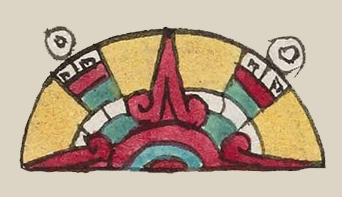teotl (Mdz51r)
This element for god or a divine force, divinity (teotl) has been carved from the compound sign for the place name, Teotlalpan. It is a half circle, half a sun disc, with multiple colors, smaller circles, and points.
Stephanie Wood
See our record for tonatiuh (sun, day) in order to compare this half disc with a full disc. The half disc is used regularly in the glyphs of the Codex Mendoza to represent the phonetic sound "teo" and a meaning of divine force(s), sun, and calendrics. Magnus Pharao Hansen and Christophe Helmke have pointed out that it is usually the upper half of the sun sign that is used for teo-, as we see here. For further discussion of teotl and tonatiuh, see the work of Hansen and Helmke in Contributions to New World Archaeology, v. 13 (Kraków, 2019).
Glyphs for teotl change considerably by the time of the Matrícula de Huexotzinco (1560), almost two decades after the Codex Mendoza was made. The half sun is abandoned in favor of a stone (te-) with a face on it (recalling Christ, perhaps, as a result of contact with Christianity), or, for Teoxoch, the flower is given a face. See examples below.
Stephanie Wood
c. 1541, or by 1553 at the latest
Stephanie Wood
deidades, fuerzas divinas, soles

teo(tl), divine force or deity, https://nahuatl.wired-humanities.org/content/teotl
las fuerzas sagradas, la deidad, dios, el sol
Stephanie Wood
Codex Mendoza, folio 51 verso, https://digital.bodleian.ox.ac.uk/objects/2fea788e-2aa2-4f08-b6d9-648c00..., image 112 of 118.
The Bodleian Libraries, University of Oxford, hold the original manuscript, the MS. Arch. Selden. A. 1. This image is published here under the UK Creative Commons, “Attribution-NonCommercial-ShareAlike 3.0 License” (CC-BY-NC-SA 3.0).









